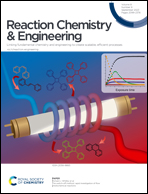Efficient removal of organic dyestuff in water contamination over a MOF-derived Co-based adsorbent†
Abstract
In this study, we developed an adsorption technology by using MOF-derived Co-based adsorbents for the efficient removal of organic dyestuff (rhodamine B) solutions. The maximum adsorption capacity of rhodamine B in an hour over Co0.5(PTA)@C (the Co-based adsorbent with the best Co/terephthalic acid molar ratio of 1 : 2) was 336.73 mg g−1, indicating that the adsorbent was promising for dye wastewater adsorption and could be widely used in practical wastewater applications. The adsorbents with different metals (Ni, Fe, Cu, and Co), ligands (trimesic acid and terephthalic acid), and metal/ligand molar ratios were evaluated and characterized by XRD, SEM, TEM, HRTEM, BET, ICP and XPS analyses. The potential mechanism of adsorption and the adsorption kinetic behavior were investigated using pseudo-first-order and pseudo-second-order kinetic models, and the experimental data were analyzed by employing Langmuir and Freundlich adsorption isotherms for assessing the adsorption processes and equilibrium properties.



 Please wait while we load your content...
Please wait while we load your content...